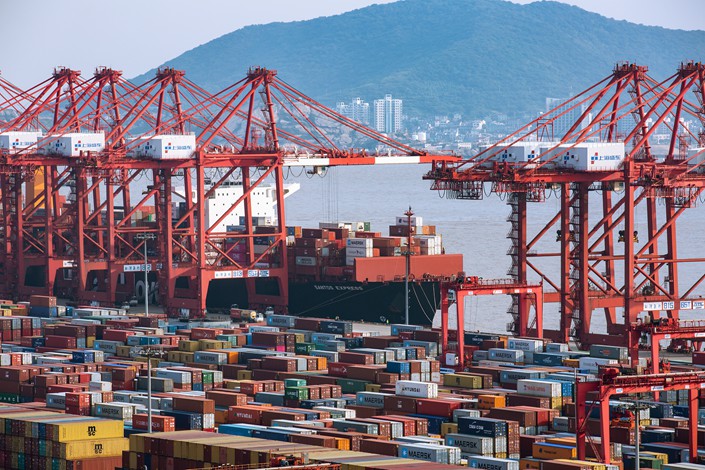Worst-Case Scenario of Trade War: 1.5 Points Off GDP Growth

A full-blown trade war with the United States will bring “substantial impacts” to the Chinese economy, dragging down growth of 15 manufacturing-related sectors, a senior policy adviser warned Tuesday.
The effects of worsening trade frictions on China’s economy are generally under control, but China should be prepared for the worst-case scenario, said Wang Yiming, a vice minister of the Development Research Center (DRC) of the State Council, a top government think tank, at a conference held by China Everbright Ltd.
If the Trump administration moves ahead with all of its threats, tariffs will cover an annual total of $517 billion in Chinese goods and will exceed last year's exports of $505 billion to the U.S. In that case, growth of China’s gross domestic product (GDP) will slow by 1.5 percentage points, Wang said. Wang was previously a deputy secretary-general of the National Development and Reform Commission, the government’s top economic-planning agency.
Worries over the trade war and waning confidence in China’s growth sent the country’s stock markets to near four-year low last week. In the July-September period, the economy expanded 6.5%, the slowest since the first quarter of 2009. In 2017, China posted 6.9% GDP growth.
Government authorities have stepped up efforts to restore market confidence, pledging more financial backing to the economy through the private sector.
Fifteen manufacturing-related industries will be hardest-hit as the U.S. targets China’s industrially significant technologies, Wang said. Radio and television equipment as well as radar and ancillary facilities are expected to slow by more than 7 percentage points because of the trade war, he said.
Over the past few months, the U.S. has levied 25% tariffs on $50 billion Chinese products a year and 10% tariffs on an additional $200 billion of Chinese exports. The punitive duties on the $200 billion of products are scheduled to rise to 25% at the beginning of 2019. President Donald Trump also threatened to tax an additional $267 billion of goods if China retaliates.
China has struck back with similar tariffs on a total of $110 billion a year of American goods.
Wang said the planned 25% levies on $250 billion of Chinese products will slow the country’s growth by 0.7 percentage point. Tariffs on the additional $267 billion of products would bring the slowdown in growth to 1.5 percentage points, he said.
Based on China’s 2017 GDP of $12.24 trillion, that would work out to an economic hit of $184 billion, or more than a third of the value of exports subjected to increased tariffs.
In June, Wang warned of downside risks to China’s economic growth in the second half because of the trade war and slowing domestic demand.
“We need to adopt bottom-line thinking and draft all types of contingency plans to take targeted measures” to “appropriately deal with the trade friction” with the U.S., he said at a June seminar.
Despite the trade war, China’s exports to the U.S. have continued to increase monthly since April, when tensions spiked as Trump unveiled the first batch of Chinese goods subject to additional tariffs. In September, sales to the U.S. hit a record $46.69 billion, up 5.2% from August. Year-on-year, exports grew at an even faster pace of 14%, according to figures released by the General Administration of Customs.
Wang said the export increase is partly because exporters rushed to ship products before new tariffs take effect and partly because of the weakening of the yuan.
The effects of the trade war are gradually shifting from market expectations to the real economy, Wang said. The impacts “are expanding from trade to investment, supply chain and employment,” he said.
Amid growing uncertainties, Chinese enterprises are likely to slow exports and new investment plans, he said. Some companies will be pressed to accelerate efforts to relocate manufacturing out of China. And technology cooperation and talent exchange between the China and U.S. may slow, Wang said.
“The recent speech by U.S. Vice President Mike Pence is worrying, as it sparked concerns that trade frictions are shifting toward an overall strategic containment against China,” Wang said. “It takes time to observe whether the U.S. view of China is changing.”
Pence earlier this month accused China of waging an “unprecedented effort to influence American public opinion” before congressional elections in November. Beijing dismissed Pence’s allegations as “slander” and “ridiculous.”
Trump and Chinese President Xi Jinping reportedly plan to meet at the late-November Group of 20 meeting of leading rich and developing nations in Buenos Aires, raising hopes that a break in the trade negotiations impasse might be on the horizon.
Contact reporter Han Wei (weihan@caixin.com)

- 1China Sets 2026 Economic Priorities With Demand Revival at the Core
- 2In Depth: China Bad-Debt Managers’ Bet on Bank Stocks Could Backfire
- 3Beijing Moves to Rein in Steel Exports With New Licensing Rule
- 4China Ramps Up Effort to Offload Vast Supply of Unsold Homes
- 5China’s Elite-Focused Schools Are Failing Most Students, Top Educators Say
- 1Power To The People: Pintec Serves A Booming Consumer Class
- 2Largest hotel group in Europe accepts UnionPay
- 3UnionPay mobile QuickPass debuts in Hong Kong
- 4UnionPay International launches premium catering privilege U Dining Collection
- 5UnionPay International’s U Plan has covered over 1600 stores overseas






